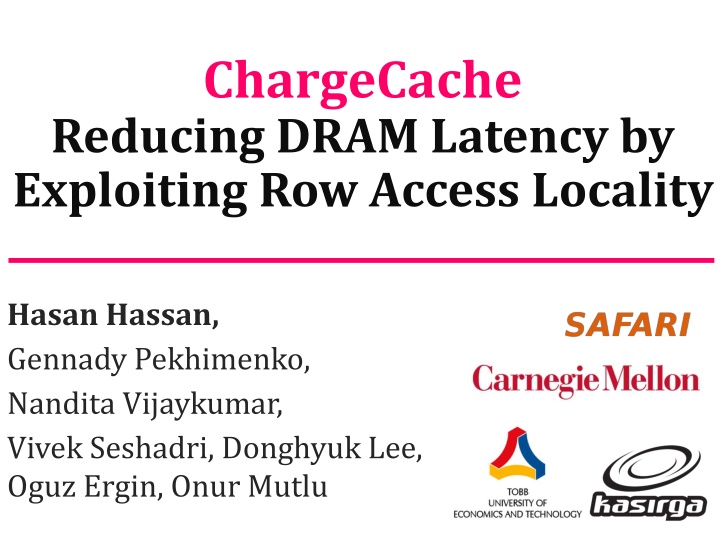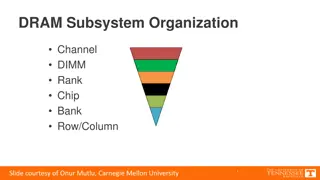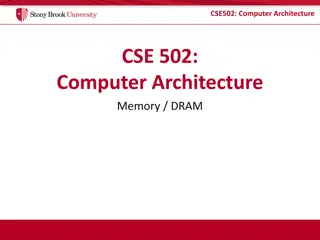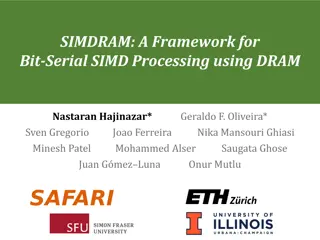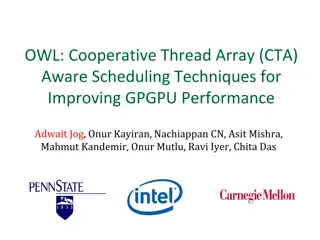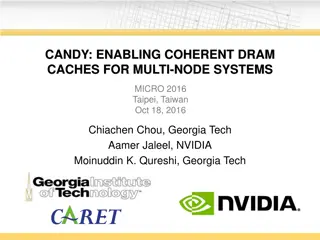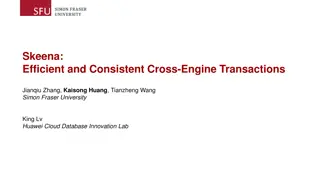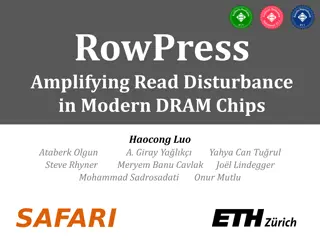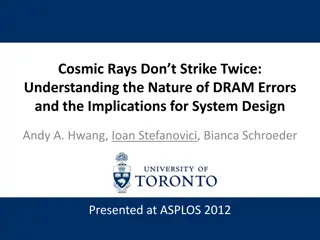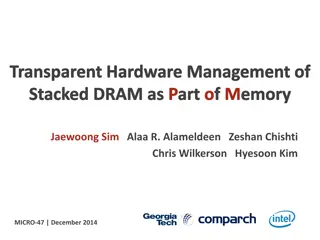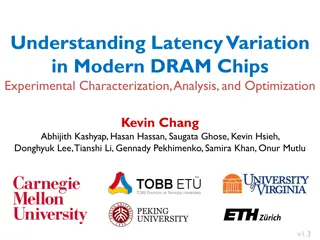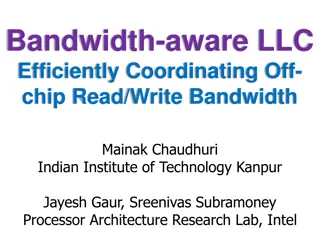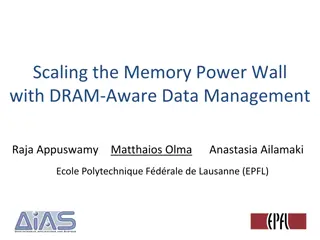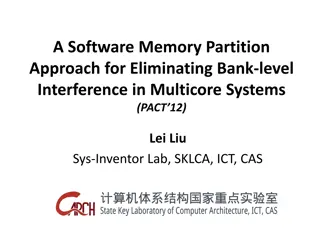Enhancing DRAM Performance with ChargeCache: A Novel Approach
Reduce average DRAM access latency by leveraging row access locality with ChargeCache, a cost-effective solution requiring no modifications to existing DRAM chips. By tracking recently accessed rows and adjusting timing parameters, ChargeCache achieves higher performance and lower DRAM energy consumption. Explore the key ideas, evaluation, and conclusion in this innovative study.
Download Presentation

Please find below an Image/Link to download the presentation.
The content on the website is provided AS IS for your information and personal use only. It may not be sold, licensed, or shared on other websites without obtaining consent from the author.If you encounter any issues during the download, it is possible that the publisher has removed the file from their server.
You are allowed to download the files provided on this website for personal or commercial use, subject to the condition that they are used lawfully. All files are the property of their respective owners.
The content on the website is provided AS IS for your information and personal use only. It may not be sold, licensed, or shared on other websites without obtaining consent from the author.
E N D
Presentation Transcript
ChargeCache Reducing DRAM Latency by Exploiting Row Access Locality Hasan Hassan, Gennady Pekhimenko, Nandita Vijaykumar, Vivek Seshadri, Donghyuk Lee, Oguz Ergin, Onur Mutlu
Executive Summary Goal: Reduce average DRAM access latency with no modification to the existing DRAM chips Observations: 1) A highly-charged DRAM row can be accessed with low latency 2) A row s charge is restored when the row is accessed 3) A recently-accessed row is likely to be accessed again: Row Level Temporal Locality (RLTL) Key Idea: Track recently-accessed DRAM rows and use lower timing parameters if such rows are accessed again ChargeCache: Low cost & no modifications to the DRAM Higher performance (8.6-10.6% on average for 8-core) Lower DRAM energy (7.9% on average) 2
Outline 1. DRAM Operation Basics 2. Accessing Highly-charged Rows 3. Row Level Temporal Locality (RLTL) 4. ChargeCache 5. Evaluation 6. Conclusion 3
DRAM Stores Data as Charge DRAM Cell Three steps of charge movement MemCtrl CPU 1. Sensing 2. Restore 3. Precharge Sense-Amplifier 4
DRAM Charge over Time Ready to Access Charge Level Ready to Precharge Ready to Access Cell Cell Data 1 charge Sense-Amplifier Sense Amplifier Data 0 Restore Sensing Precharge time tRCD ACT R/W PRE tRAS 5
Outline 1. DRAM Operation Basics 2. Accessing Highly-charged Rows 3. Row Level Temporal Locality (RLTL) 4. ChargeCache 5. Evaluation 6. Conclusion 6
Accessing Highly-charged Rows Ready to Access Ready to Precharge Cell Data 1 charge Sense-Amplifier Data 0 Restore Sensing tRCD Precharge time ACT R/W R/W PRE PRE tRAS 7
Observation 1 A highly-charged DRAM row can be accessed with low latency tRCD: 44% 44% tRAS: 37 37% % How does a row become highly-charged? 8
How Does a Row Become Highly-Charged? DRAM cells lose charge over time Two ways of restoring a row s charge: Refresh Operation Access charge time Access Refresh Refresh 9
Observation 2 A row s charge is restored when the row is accessed How likely is a recently-accessed row to be accessed again? 10
Outline 1. DRAM Operation Basics 2. Accessing Highly-charged Rows 3. Row Level Temporal Locality (RLTL) 4. ChargeCache 5. Evaluation 6. Conclusion 11
Row Level Temporal Locality (RLTL) A recently-accessed DRAM row is likely to be accessed again. t-RLTL: Fraction of rows that are accessed within time t after their previous access 86% 97% 100% 100% Fraction of Accesses Fraction of Accesses 80% 80% 60% 60% 40% 40% 20% 20% 0% 0% 8ms RLTL for single-core workloads 8ms RLTL for eight-core workloads 12
Outline 1. DRAM Operation Basics 2. Accessing Highly-charged Rows 3. Row Level Temporal Locality (RLTL) 4. ChargeCache 5. Evaluation 6. Conclusion 13
Summary of the Observations 1. A highly-charged DRAM row can be accessed with low latency 2. A row s charge is restored when the row is accessed 3. A recently-accessed DRAM row is likely to be accessed again: Row Level Temporal Locality (RLTL) 14
Key Idea Track recently-accessed DRAM rows and use lower timing parameters if such rows are accessed again 15
ChargeCache Overview DRAM :A Memory Controller :B :C ChargeCache A D :D :E :F A D A Requests: ChargeCache Miss: Use Default Timings ChargeCache Hit: Use Lower Timings 16
Area and Power Overhead Modeled with CACTI Area ~5KB for 128-entry ChargeCache 0.24% of a 4MB Last Level Cache (LLC) area Power Consumption 0.15 mW on average (static + dynamic) 0.23% of the 4MB LLC power consumption 17
Outline 1. DRAM Operation Basics 2. Accessing Highly-charged Rows 3. Row Level Temporal Locality (RLTL) 4. ChargeCache 5. Evaluation 6. Conclusion 18
Methodology Simulator DRAM Simulator (Ramulator [Kim+, CAL 15]) https://github.com/CMU-SAFARI/ramulator Workloads 22 single-core workloads SPEC CPU2006, TPC, STREAM 20 multi-programmed 8-core workloads By randomly choosing from single-core workloads Execute at least 1 billion representative instructions per core (Pinpoints) System Parameters 1/8 core system with 4MB LLC Default tRCD/tRAS of 11/28 cycles 19
Mechanisms Evaluated Non-Uniform Access Time Memory Controller (NUAT) [Shin+, HPCA 14] Key idea: Access only recently-refreshed rows with lower timing parameters Recently-refreshed rows can be accessed faster Only a small fraction (10-12%) of accesses go to recently-refreshed rows ChargeCache Recently-accessed rows can be accessed faster A large fraction (86-97%) of accesses go to recently- accessed rows (RLTL) 128 entries per core, On hit: tRCD-7, tRAS-20 cycles Upper Bound: Low Latency DRAM Works as ChargeCache with 100% Hit Ratio On all DRAM accesses: tRCD-7, tRAS-20 cycles 20
Single-core Performance NUAT ChargeCache LL-DRAM (Upper bound) ChargeCache + NUAT 16% Speedup 12% 8% 4% 0% ChargeCache improves single-core performance 21
Eight-core Performance NUAT 2.5% 9% ChargeCache LL-DRAM (Upperbound) ChargeCache + NUAT 13% 16% Speedup 12% 8% 4% 0% ChargeCache significantly improves multi-core performance 22
DRAM Energy Savings 15% Average Maximum DRAM Energy Reduction 10% 5% 0% Single-core Eight-core ChargeCache reduces DRAM energy 23
Other Results In The Paper Detailed analysis of the Row Level Temporal Locality phenomenon ChargeCache hit-rate analysis Sensitivity studies oSensitivity to t in t-RLTL oChargeCache capacity 24
Outline 1. DRAM Operation Basics 2. Accessing Highly-charged Rows 3. Row Level Temporal Locality (RLTL) 4. ChargeCache 5. Evaluation 6. Conclusion 25
Conclusion ChargeCache reduces average DRAM access latency at low cost Observations: 1) A highly-charged DRAM row can be accessed with low latency 2) A row s charge is restored when the row is accessed 3) A recently-accessed row is likely to be accessed again: Row Level Temporal Locality (RLTL) Key Idea: Track recently-accessed DRAM rows and use lower timing parameters if such rows are accessed again ChargeCache: Low cost & no modifications to the DRAM Higher performance (8.6-10.6% on average for 8-core) Lower DRAM energy (7.9% on average) Source code will be available in May https://github.com/CMU-SAFARI 26
ChargeCache Reducing DRAM Latency by Exploiting Row Access Locality Hasan Hassan, Gennady Pekhimenko, Nandita Vijaykumar, Vivek Seshadri, Donghyuk Lee, Oguz Ergin, Onur Mutlu
Detailed Design Highly-charged Row Address Cache (HCRAC) PRE Insert Row Address 1 3 Invalidation Mechanism ACT Lookup the Address 2 29
RLTL Distribution RLTL Distribution 0.125ms - RLTL 0.25ms - RLTL 0.5ms - RLTL 1ms - RLTL 32ms - RLTL 100 Fraction of Accesses 80 60 40 20 0 cactusADM sjeng apache20 mcf astar STREAMcopy milc bwaves lbm hmmer tpcc64 spolex lislie3d GemsFDTD libquantum AVERAGE tpch17 sphinx3 tonto tpch6 tpch2 omnetpp bzip2 30
Sensitivity on Capacity Sensitivity on Capacity 31
Hit Hit- -rate Analysis rate Analysis 32
Sensitivity on t Sensitivity on t- -RLTL RLTL 33
